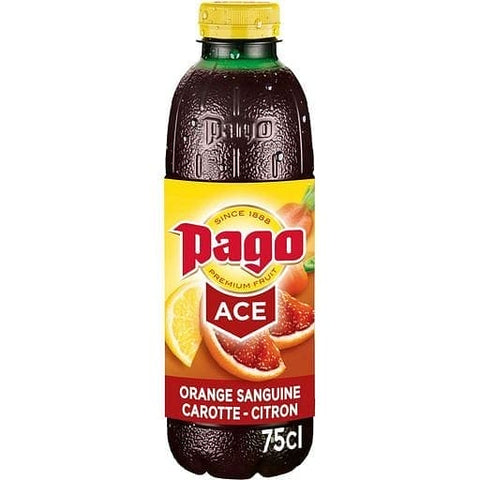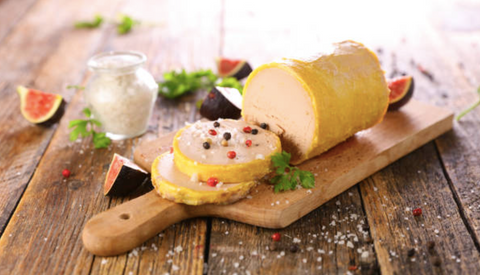Tarte Tatin is a French dessert of fruit caramelized in butter and sugar, then baked in a crust. The first known recipe for tarte Tatin was an accidental creation by Stephanie Tatin, who ran the Hotel Tatin in Lamotte-Beuvron in Sologne, south of Paris. She forgot to put a base pastry in the pan, put the fruit on top of the pastry round, and then put it in the oven. She found that the pastry was on top instead of underneath when she tried to turn it out. So she served it like that — with the caramelized fruit upside down on top — and it became very popular. The legend is that her sister, Caroline Tatin, actually invented the recipe.
History and Etymology
The date of its origin is uncertain: one source says it was created at the beginning of the 20th century; another that it was made "many years ago"; another says 1887; another that it was created before 1889 when L'Hotel Tatin was built; yet another says 1895; while others say 1901 or 1902.
- Some sources say that one of the sisters accidentally left a dish of apples cooking too long and attempted to redeem them by putting pastry over them, baking them further

Components of La tarte Tatin
La tarte Tatin is an upside-down pastry named after the Tatin sisters, who made it famous at their French hotel. The tart consists of a circle of puff pastry laid on top of fruit caramelized in butter and sugar.
The original variety of the tart was made with apples,
- Today you can find Tarte Tatins made with almost any type of fruit, including pears, pineapple, and even bananas.
- Because the fruits are caramelized first before the tart is baked, the sugar and fruit juices form sticky syrup at the bottom of the pan.
Meaning of Tatin in Tarte Tatin
The word Tatin, when capitalized, refers to the Tatin sisters, who owned the Hotel Tatin in Lamotte-Beuvron, France. In 1889, legend has it that one of the sisters dropped a pie she was preparing into an oven. To hide her mistake, she put pastry on top of the pie and baked it until golden brown. The Tarte Tatin was born.
The general recipe for a tarte Tatin calls for butter, sugar, and apples (or other fruit) cooked on the stove until caramelized. Then a round of puff pastry (or other short crust pastry) is placed over the fruit filling, and the whole thing is baked in an oven until fully cooked. Once out of the oven, the tart is turned upside down. So the fruit caramel forms a crust on top of the tart. The general recipe is here to give you amazing taste.
Difference between a tart and a tarte Tatin
The difference between a tart and a tarte Tatin is how you make it.
- The traditional French tarte Tatin uses a round baking dish or skillet filled with caramelized sugar and butter (or a mixture of both), topped with fruit, and then covered with pastry. The pastry is baked in the oven in the same pan as the filling and then flipped over to reveal a beautiful upside-down pie.
- On the other hand, a tart is made by baking a pastry shell in a metal pan and then filling it with fruit or other ingredients after the fact. So, for example, you could make a classic apple tart by baking an applesauce filling inside a pre-baked pastry shell.
They are both French and sweet, but there is a difference. A tart is not the same thing as a tarte Tatin.
A tart traditional recipe is any pastry with a filling in it. The pastry can be anything from puff pastry to pie crust to phyllo dough, and the filling can be sweet or savory -- eggs, cheese, fruit, chocolate, custard, or something else. It can be baked in a tart pan with a shortening-based crust and fluted edges or on a pie plate.
Tarte Tatin traditional recipe is a caramelized apple dessert that originated at Hotel Tatin in Lamotte-Beuvron, France. It's made by caramelizing apples (or some other fruit) on the stovetop with sugar and butter before topping them with pastry dough and baking the whole thing in an oven.
The finished product is served upside down so that the caramel sauce ends up on top of the pastry.
Eating Tarte Tatin Hot or Cold
The tarte Tatin is a very French dessert. It's also a fairly recent invention, dating from the late 19th century in the Loire Valley. It was originally made with apples, but today you will find it made with all kinds of fruit - pear, plum, and apricots.
I like to eat it when it has cooled down, but not cold.
- It is better when the pastry is crisp and the fruit filling is warm. The tarte Tatin is a French apple pie upside down, as the name suggests.
- However, instead of being covered in pastry and then topped with fruit. Instead, the apples are caramelized in butter and sugar then topped with a pastry lid before being baked.
Whether it's best served hot or cold – there's no right answer here: both are delicious. Some prefer it cold as a dessert and serve it warm as pudding. Others insist that hot is fine for breakfast; it should be eaten cold alongside cheese or ice cream at dinner.
What is a peasant tart?
A peasant tart is a rustic French tart filled with any combination of fruits, nuts, cheeses, or vegetables. The only requirement is that the filling is seasonal and local.
The crust is usually made with a large proportion of olive oil, making it easy to handle. So easy that even those who have sworn off making homemade pie crusts will find this dough a breeze.
You can make the dough by hand or with an electric mixer. Either way, it comes together in less than 5 minutes. The olive oil makes the dough very tender and pliable, so you can use your hands to press it into a fairly thin layer (1/8 inch thick) without fear of tearing or breaking it.
If you are using fruit for your filling,
- There’s no need to precook it; the tart bakes for long enough that the fruit softens completely during baking.
- If using vegetables (such as tomatoes), cook them briefly — just until they soften — before adding them to the tart shell.
Taste of Tarte Tatin
It's a not-so-sweet dessert, and it is a little bit savory with the apple and caramel. It's also buttery. It's a very rich dessert, which is why you only want to eat one or two slices of it. I mean, it sounds terrible to say that, but it's very rich.
The best way to describe it is a savory caramel apple pie. The sugar and butter are caramelized, which adds a slightly salty note. It's sweet, but not overwhelmingly so.
What kinds of apples are good for tarts?
Tart apple varieties are classified as such because of their high acid and low sugar content. The purpose of this is to allow for a nicely balanced final product. Apples like Granny Smith, Honeycrisp, Braeburn, and Pink Lady (Cripps Pink) are great tart apples that do well in pies and tarts.
- Many apples can be used in pies, but not all make the best pies. Some apples are too sweet, some have a grainy texture, and some have too much water. I've given a lot of thought to this question over the years, and here is my answer: The best apples for pies are Granny Smith or Cortland.
- For crusts, either Granny Smith or Cortland will work well. Both have enough acidity to keep the dough from being soggy. The Cortland has enough acid to keep it from browning quickly when cut, so it's nice for an open-faced tart.
- Golden Delicious is also a good choice because it cooks down to a creamy consistency and has just enough acidity to hold its shape well. It lacks the tanginess of Granny Smith or Cortland but has a lovely mild sweetness that makes it perfect for a sweet dessert filling.
What apples should not be used for apple pie?
Apples should not be used for apple pie, including Gala or Red Delicious. They are too sweet and tender flesh that doesn't hold up well when cooked.
- Red Delicious
- Braeburns
- Granny Smiths (unless paired with sweeter apples)
Avoid Tarte Tatin from sticking
What is the best way to keep a Tarte Tatin from sticking to the plate when it's turned out? It seems like no matter what I do, it still sticks.
- I've tried using a well-buttered pan and then putting the apples in and sprinkling them with sugar, caramelizing it before I put the pastry on. It is still stuck.
- I've tried using a nonstick pan and buttering it well before sprinkling the sugar and putting the apples in. It stuck.
- I've tried using a normal pan with butter and flour, it stuck.
The only thing that worked was spraying it with oil (but I don't want to use that because of health reasons)
Popularity of Tarte Tatin
The Tarte Tatin, a French upside-down apple pie, has been around since the late 1800s. It's said that the recipe was invented by accident at the Hotel Tatin in France when the cook left apples cooking in butter and sugar for too long, causing the butter and sugar to caramelize. She then covered the pan with dough and put it in the oven. When she flipped it over, she had a new dessert. The tart recipe became famous when Auguste Escoffier was included in his 1888 cookbook.
The pastry is made of thinly sliced apples tossed in butter and sugar that are slowly cooked until caramelized before being covered with pastry dough. The pastry is baked until golden brown, and then turned over to serve.
On this day, we celebrate this delicious French dessert that has become popular worldwide. So you can enjoy this recipe by using instructions from allrecipes website.
Freezing Tarte Tatin
Yes! Tartes Tatin can be frozen, and they freeze well. If you have any leftovers, wrap them up well in plastic wrap and keep them in the fridge or freezer. You can freeze this apple Tart Tatin for up to 2 months.
Tarte Tatin is a dessert
According to cooking nytimes Tarte Tatin is a French upside-down tart in which the fruit (usually apples) is caramelized in butter and sugar before the tart is baked. It's then inverted onto a serving plate, so the fruit ends on top.
- It's an easy dessert to make, as long as you're paying attention while making it.
- The butter and sugar caramelize quickly, so it's important to watch them while they're cooking.
The trickiest part of making Tarte Tatin is inverting it onto a plate when it's done baking. You have to be quick and confident and do it before the caramel has time to cool too much, or it gets too stiff and doesn't run down over the fruit.
Storing Tarte Tatin
Tarte Tatin can be stored in the fridge for a good couple of days. After that, I suggest you put it in a container that is airtight and then reheat it from cold in the oven, at about 180C, for about 10 to 15 minutes.
It will also help make the caramel just before you cook the apples, as it tastes better warm than cold.
Cooking a frozen Tarte Tatin
It depends on what size the tart is and if it's already in a metal tray that can be put in the oven.
- If it's frozen in a plastic container, defrost it on the kitchen counter for a few hours. Then heat the oven to 160C fan-forced and place the tart on a baking tray in the oven for about 20 minutes or until it starts to brown.
- If it's frozen in an aluminum tray, you can heat it straight from the freezer at 180C fan-forced for 30 minutes or so (check after 25 minutes).
- Either way, keep an eye on it during cooking, so it doesn't burn. Once cooked, leave to cool and turn it out onto a serving plate.
So, we may say that Tarte Tatin is famous French food, and you must have to try it once by checking it here.




